The Historical Flags of Germany Part 4
| Top of the page | The Holy Roman Empire | Prussian Flags Before 1800 | Prussian Flags 1800-1892 |
| Prussian Flags After 1900 | Imperial Germany Era Flags | German Colonial Flags | Weimar Republic Era Flags |
| Third Reich Era Civil and Political Flags | Third Reich Era Military Flags | Modern Era Flags |
Modern German Era Flags 1946 to present
With the defeat of Nazi Germany by Allied forces at the end of World War II, once again Germany would find itself conquered and occupied. From the east had come the forces of Soviet Russia and from the west the forces of the democratic west, and this time, deep political and social divisions existed resulting in a divided Germany for the next 50 years. The "Cold War" between the east and west had begun, and nowhere else in the world was it so apparent as in Berlin, a island city divided into East and West Berlin, located behind the "Iron Curtin" which divided East and West Germany and the world, and marking the beginning of a 50-year worldwide struggle between the "Superpowers" of the communist USSR and the capitalistic and democratic USA.

Buchenwald Camp 1945
|
Buchenwald German Camp Flag 1945
When the Buchenwald Concentration Camp was liberated by the Americans on April 11, 1945, committees were formed to represent the prisoners of each nationality. On April 30, they organized a demonstration to celebrate the First of May. Each nationality chose to display a flag, and after much debate Germany was represented by a red flag with a gold five-pointed star in the center. The choice was not surprising as the Germany camp committee was dominated by Communist prisoners at the time.
Interestingly, this flag was identical to the North Vietnam Flag first used by the Viet Minh against the French in 1940, and later adopted as the national flag of North Vietnam in 1945, the same year it was used at Buchenwald. It became the national flag of the unified Vietnam in 1976.
|

German C-Pennant
|
The C-Doppelstander ("C" Pennant) 1946-1949
After the defeat of Germany in World War II, the country was placed under Allied administration. Although there was no national German government and no German flag, German ships were required by international law to have a national ensign of some kind.
As a provisional civil ensign of Germany, the Council designated the international signal pennant representing the letter "C" ending in a swallowtail, known as the C-Pennant. The Council ruled that "no ceremonial shall be accorded this flag which shall not be dipped in salute to warships or merchant ships of any nationality."
|
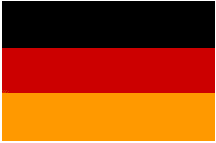
German National Flag
NOTE: The flags of the Federal Republic of Germany continued to be used after the reunification of East and West Germany in 1990. From this point onwards the FRG flags represented the unified Germany down to the present day. |
The Federal Republic of Germany Flag since 1949 and
The German Democratic Republic Flag between 1949-1959
The Federal Republic of Germany, or West Germany, was formed from the Western Allies part of conquered Germany, with Bonn as its capitol. The city of Berlin, located 30 miles inside of East Germany, was divided into West and East Berlin. West Berlin, located on the Soviet side of Germany, was still part of West Germany. Stalin tried to starve the West Berliners into submission during the "Berlin Blockade" in 1948, but the United States successful flew supplies into the beleaguered city in the "Berlin Airlift" until Stalin backed down and lifted the blockade. The Communists built the "Berlin Wall" across the city and it became a symbol of the Cold War.
It is interesting that the flag of the German Democratic Republic (East Germany) was the same as the flag for the Federal Republic of Germany (West Germany) from 1949 to 1959, i.e. both countries used the simple striped black-red-gold flag without a coat of arms. Only in 1959, the GDR decided to insert the arms of the state in order to distinguish it from the FRG flag. Today, this flag is once again the flag of both Germanies.
|
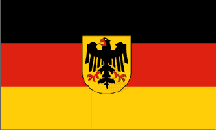
West Germany Service Flag
|
The Federal Republic of Germany Service Flag since 1949
This flag with the "Bundesschild" (a special coat of arms) on it, is called "Bundesdienstflagge," which can be translated as "Service Flag for Federal Institutions."
This flag is presently used by all the military forces of Germany stationed on land. The military forces at sea are using a special "Bundesdienstflagge" that is swallow-tailed.
There is one exception for the use of this flag at sea: The "Bundespolizei" (Federal Police), who are responsible, amongst other things, for the protection of the external borders of Germany, is using the rectangular version of the "Bundesdienstflagge" on sea. |

West Germany Service Flag
(at Sea)
|
The Federal Republic of Germany Naval Service Flag since 1949
The German military forces at sea are using this special swallow-tailed "Bundesdienstflagge." This swallow-tailed flag is used as ensign and also as jack, the latter in
scaled down size.
Swallow-tailed flags are commonly used in the region of the North Sea and Baltic Sea for warships; for example in Danmark, Sweden, Norway, Finland, Poland and Estland. By means of this special shape, as well as referencing to the "Bundesdienstflagge," the Federal Republic of Germany is distancing itself from the "Reichskriegsflaggen" (War flags) that were used from 1871 on.
|
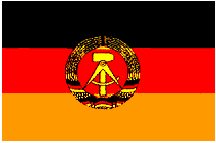
Communist East Germany
|
The German Democratic Republic Flag 1959-1990
At the end of World War II, the USSR set up friendly buffer nations in Eastern Europe. The German Democratic Republic, or East Germany, was one of those "satellite" nations, with East Berlin as its capital.
The Soviet Union then basically dismantled East German factories and shipped them back to Russia along with any other resources they could take, then set up a puppet communist government in charge of what remained. |
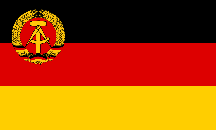
East German Merchant Flag
|
The German Democratic Republic Merchant Flag 1959-1973
In 1959, the Communist East Germans (GDR) introduced a special Merchant Flag, which was used until 1973. This flag was only used until 1973 because the leaders of the GDR thought that the coat-of-arms was too small, as displayed on the Merchant Flag, and that it might have been mistaken for the flag of the Federal Republic of Germany.
From 1973 until 1990, the GDR National flag also became their Merchant flag. |
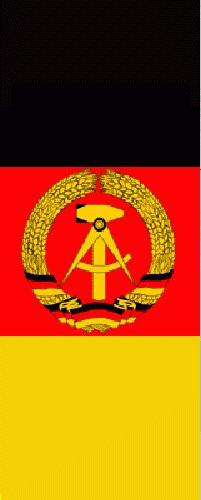
East German Vertical Banner
|
German Democratic Republic Vertical Banner/Flag 1963-1990
Deutsche Demokratische Republik (DDR)
The German Democratic Republic Vertical Banner/Flag was in use as early as 1963 and continued to be used until the reunification of German in 1990. It was used at ceremonies and official events as a decorative item, and was seen at such public places as check points, public plazas, and assembly halls (Checkpoint Selmsdorf near Lübeck and the Alexanderplatz in East Berlin, for example). It was appeared on a East German postage stamp (15 years anniversary stamp of DDR, 1964).
The ratio of this banner is approximately 5:2. The coat of arms is completely within the red stripe. The flag is horizontally divided into black over red over yellow. |

Bonn City Flag
|
Flag of the City of Bonn 1971
This is the flag of the City of Bonn which would act as capital of West Germany for 50 years until Germany was reunited and the infamous Berlin Wall torn down. Since the traditional capital city of Germany was Berlin, which found itself divided into West Berlin and East Berlin and actually located 60 miles behind the Iron Curtin in East Germany, the City of Bonn became the new capital of the Federal Republic of Germany.
Bonn is located in the Cologne/Bonn Region, about 20 kilometres south of Cologne on the river Rhine in the Federal State of North Rhine-Westphalia. It was the capital of West Germany from 1949 to 1990 and the official seat of government of united Germany from 1990 to 1999. Bonn is about the 19th largest city in Germany. |
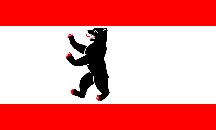
West Berlin City Flag
1954-1990
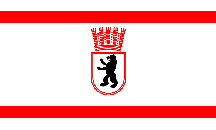
East Berlin City Flag
1954-1990
|
Flags of the City of Berlin 1954-present
Founded in the thirteenth century, Berlin was successively the capital of the Kingdom of Prussia (1701–1918), the German Empire (1871–1918), the Weimar Republic (1919–1933) and the Third Reich (1933–1945). After World War II, the city was divided; East Berlin became the capital of East Germany while West Berlin became a Western exclave, surrounded by the Berlin Wall (1961–1989). Today, Berlin is once again the capital city of Germany and one of sixteen states of Germany. With a population of 3.4 million, Berlin is Germany's largest city.
The bear on the flag and coat of arms of Berlin represents the first half of the city's name, German Bär, meaning "bear."
Between 1913 and 1954, the civil flag was similar to the current one, except the design of the bear was different. It wasn't until 1935 that the emblem's design was fixed and many variants existed. When Berlin was split into West and East Berlin, the East Berlin flag was modified with the addition of two white stripes outside the upper and lower red stripes, a slightly different designed bear was placed inside an escutcheon, which was then topped with a crown. During this period the West Berlin Flag remained same as it had been prior to the split.
After 1990, the West Berlin flag was again adopted for the whole of Berlin, and remains Berlin's only flag. |
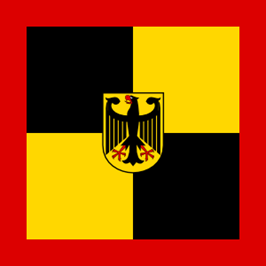
Generalinspekteur
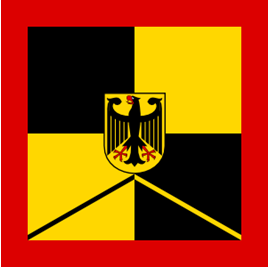
Deputy Generalinspekteur
|
Vehicle Command Flag for the Generalinspekteur der Bundeswehr
(Chief of Staff of the Bundeswehr) 1959-present
The Generalinspekteur der Bundeswehr (GenInspBw)) is the highest-ranking military post in the Bundeswehr, the modern German armed forces. Normally, his rank of that of a (four star) General or Admiral.
The Generalinspekteurheads the "Führungsstab der Streitkräfte" (German General Staff), and is the direct military advisor to the Federal Minister of Defence. The Generalinspekteur has two deputies, one of them is the chief of the "Zentralen militärischen Dienststellen" (Central military offices), the second is the "Inspekteur der Streitkräftebasis" (Inspector for the base of the Armed forces).
In 1959, the Generalinspekteur received a special command flag consisting of a square of black and yellow-quartered field, surrounded by a small red border. In the center of the field there is the Federal eagle, displayed in a strong "Prussian" fashion, contrary to the somewhat rounded version that can be seen on the flags for most Federal German authorities (for example, the Service Flag).
In 1995, the Deputy of the Generalinspekteur was given his own special command flag. It is the same as the Generalinspekteur's one, but with the addition of two small stripes in the lower part of the flag, one in black, the second in yellow, in order to contrast the squares. A further difference is the size of the standard. While the Generalinspekteur has a square of 30x30 cm the Deputy Generalinspekteur uses a standard of 22x22 cm. |
- My thanks to "Fornax" for all his expert help, research, advise, and images used on this page -
| Top of the page | The Holy Roman Empire | Prussian Flags Before 1800 | Prussian Flags 1800-1892 |
| Prussian Flags After 1900 | Imperial Germany Era Flags | German Colonial Flags | Weimar Republic Era Flags |
| Third Reich Era Civil and Political Flags | Third Reich Era Military Flags | Modern Era Flags |
|